Roasted Tomatillo Salsa Verde Canning Recipe
This post may contain affiliate links, which means that I may receive a commission if you make a purchase using these links. As an Amazon Associate I earn from qualifying purchases.
Canning roasted tomatillo salsa is a great way to preserve the abundance of tomatillos that the garden produces. Jars of tomatillo salsa verde come in handy for all your favorite Mexican dishes.
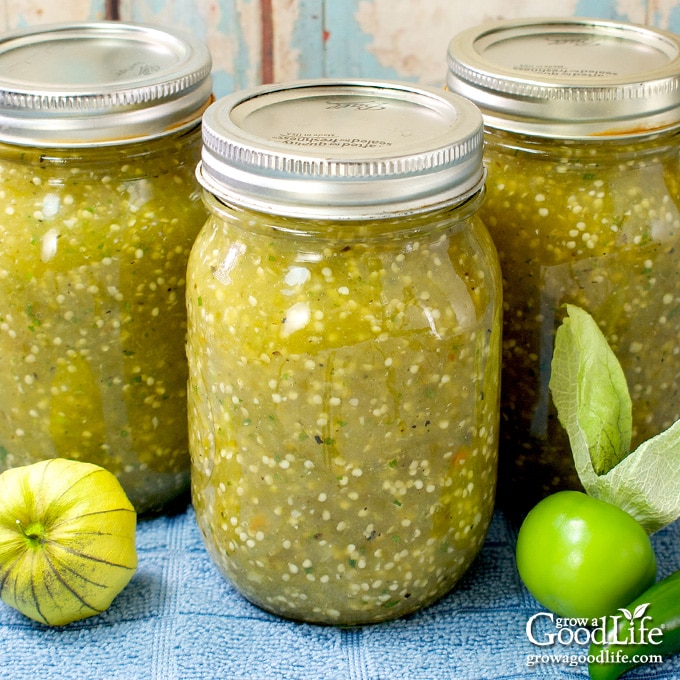
The first time I grew tomatillos in the garden, I thought six plants would be a good number to grow. Ok, ok, I hear the snickers from those of you with experience growing tomatillos.
Tomatillos (Physalis philadelphica), also called husk tomatoes, are native to Mexico and are not very common to our corner of the world, Maine. They are related to the tomato, but grow enclosed in a papery husk.
Tomatillos produce a lot of fruit even when growing in cooler climates, so consider yourself warned if you are thinking of growing some for the first time. Each plant can put out about ten to fifteen pounds.
On a positive note, I had a lot of tomatillos to experiment with. Biting into my first ripe fruit was an unexpected pleasure. I thought it would taste similar to a tomato. Instead, it has a tart and slightly citrus flavor.
The first thing I tried is making with tomatillos was a small batch of salsa verde. It was good! Then I tried roasting it. Roasting the vegetables adds a delicious smoky flavor and mellows the acidity of the tomatillos: Small Batch Roasted Salsa Verde Recipe.
Finding a safe canning recipe for salsa verde that tasted good was challenging. In fact, the recipe I published here previously from the NCHFP website required bottled lemon juice to make it safe for home canning. Many commented that there was too much lemon flavor, and I had to agree.
Finally, I tried a salsa verde recipe from The All New Ball Book of Canning and Preserving that uses fresh lime juice and cilantro. I tested it several times, and it tastes so much better. If you tried the old recipe and were disappointed with the lemon flavor, please give this one a shot.
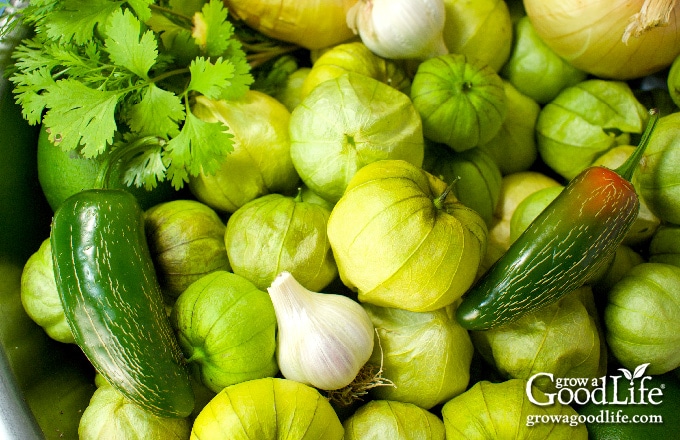
This roasted tomatillo salsa is delicious as a dip with tortilla chips, drizzled on tacos and fajitas. We also like it pouring it over some boneless chicken breasts and cooking in a crockpot to make shredded chicken for salsa verde chicken enchiladas similar to this recipe.
Steps for Canning Roasted Tomatillo Salsa
Tomatillos are easy to preserve into jars of salsa verde. There is no peeling or seeding, simply roast the vegetables, combine the ingredients, blend together, simmer briefly, and process in a water bath canner.
When canning, it is important to follow a recipe that has been scientifically tested. This is the “Roasted Salsa Verde” recipe from The All New Ball Book of Canning and Preserving. It has been doubled for a canner load of 6 pint-sized jars, and the seasonings have been adjusted.
If you are new to canning, it may be helpful to review this article on water bath canning at the National Center for Home Food Preservation website.
A more detailed and printable recipe can be found at the bottom of this article. These are the illustrated steps for making and preserving roasted tomatillo salsa in a water bath canner:
Step 1: Gather the Kitchen Equipment
- 4 rimmed baking sheets or a large roasting pans to roast the vegetables
- Rubber gloves for handling hot peppers
- Food processor to blend the salsa
- Kitchen scale
- Water bath canner and canning rack
- 6 pint sized canning jars
- Canning lids and bands (new lids for each jar, bands can be reused)
- Canning tools: jar lifter, canning ladle, funnel, and bubble popper
- Plus basic kitchen supplies such as a large prep bowl, large saucepan, towels, knife, and a cutting board.
Step 2: Prepare the Vegetables
Peel the husks off the tomatillos and rinse them well to remove the sticky residue. Cut the tomatillos in half and add to the roasting pans. Peel and cut your onions into chunks, wash the jalapeño peppers and add them whole to the roasting pans. Peel your garlic and scatter them over the vegetables.
Roast the vegetables in a preheated oven until everything is softened and charred, about 15-20 minutes. Flip half way through so the vegetables roast evenly. Remove the pan from the oven and let it cool for 5-10 minutes.
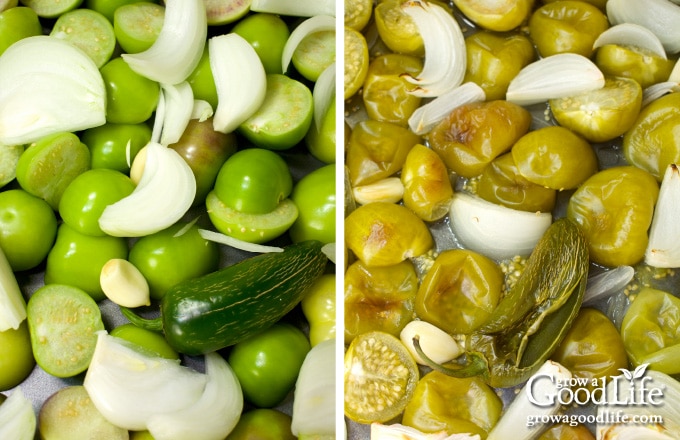
Step 3: Prepare the Canning Jars and Lids
While the vegetables are roasting, prepare the jars, set up the canner, and organize your work area.
Wash your canning jars, lids and bands, and canning tools with warm, soapy water and rinse well. Look the jars over carefully, and eliminate any with chips and cracks. Set lids and bands aside until you are ready to use them.
Place the canner on the stove and insert the canning rack. Set the jars in the canner, add water to cover, and simmer (180˚F) for 10 minutes. Keep hot until you are ready to fill them.
Step 4: Make the Salsa Verde
While wearing gloves, remove stems and seeds from the jalapeño peppers. You can keep the seeds if you like more heat.
Working in batches, add the roasted vegetables and their liquid to a food processor. Process until smooth, and then pour into a large sauce pot. Continue processing the vegetables in batches until done.
Add the lime juice, cilantro leaves, salt, pepper, cumin and stir to combine. Bring the pot to a simmer (180˚F), and then turn the heat to low and keep warm.
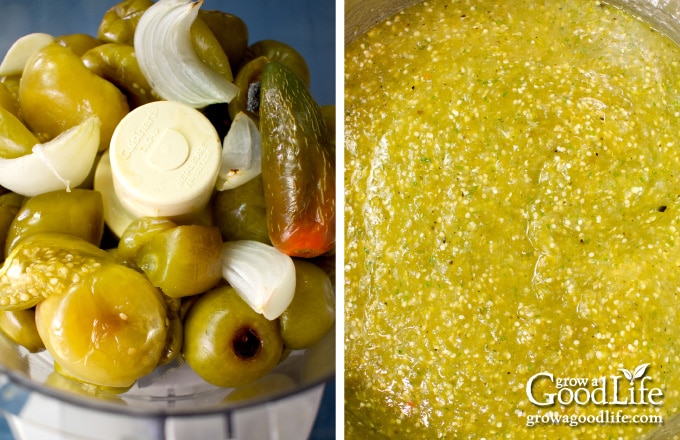
Step 5: Can the Salsa
Spread a dry kitchen towel on the counter. Use the jar lifter to remove a hot jar from the canner, drain, and place on the towel. Keep the remaining jars in the canner, so they stay warm.
Place the canning funnel on the jar, and ladle the hot salsa into the jar while leaving 1/2-inch headspace. Run the bubble popper through the jar to release any trapped air bubbles. Adjust the headspace again if needed.
Wipe the rim with a damp towel to remove residue. Center a lid on the jar, add the band, and screw it on until fingertip tight. Place the jar back into the canner, and repeat with the rest of the jars.
Adjust the water level so it is covering the jars by two-inches, cover the canner, bring it to a boil, and process the jars in a boiling-water canner for the times indicated in the recipe below.
Once processing time is complete, remove the jars, and let them cool undisturbed for 12 to 24 hours. After cooling for at least 12 hours, test the seals. Refrigerate any that did not seal, and use up within a week.
Wash the jars with warm soapy water, dry, label and date the jars, and store in a cool, dark location for 12 to 18 months. Wait several weeks for the salsa to develop its flavor before opening a jar.
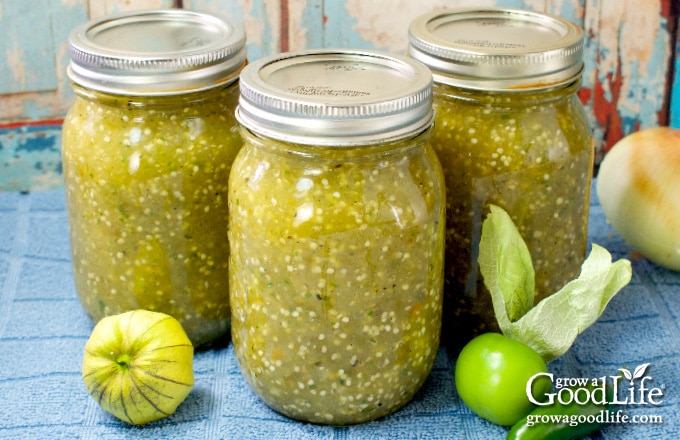
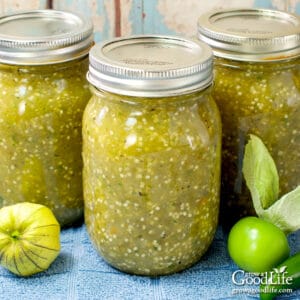
Roasted Tomatillo Salsa Verde Canning Recipe
Ingredients
- 8 pounds tomatillos husks removed
- 4 medium white onions cut into wedges
- 4 jalapeño chiles or serrano peppers
- 6 cloves garlic peeled
- 1 cup fresh lime juice or bottled lime juice
- 1/2 cup chopped fresh cilantro leaves
- 2 teaspoons kosher salt (optional for flavor)
- 1 teaspoon black pepper (optional for flavor)
- 1/2 teaspoon ground cumin (optional for flavor)
Instructions
Prepare the Vegetables:
- Preheat oven to 425˚F.
- Peel the husks off the tomatillos and rinse them well. Cut the tomatillos in half and divide up into the rimmed baking sheets or roasting pans.
- Peel and cut your onions into chunks. Add to the roasting pans.
- Wash the jalapeño peppers and add them whole to the roasting pans.
- Peel your garlic, and scatter into the roasting pans.
- Roast the vegetables in a preheated oven until everything is slightly softened and charred, about 15-20 minutes. Flip half way through so the vegetables roast evenly.
- Remove the baking sheets from the oven and let the roasted vegetables cool for 5-10 minutes.
Prepare your Canning Equipment:
- Wash your jars, lids, screw bands, and canning tools in hot soapy water. Rinse thoroughly to remove all suds. Set aside to air dry on a clean kitchen towel.
- Place the jar rack into water bath canner, place jars in the canner, and add water to cover. Bring the canner to a simmer (180˚F) for 10 minutes, and keep the jars hot until you are ready to fill them.
Make the Tomatillo Salsa Verde:
- While wearing gloves, remove stems and seeds from the jalapeño peppers. You can keep the seeds if you like more heat.
- Working in batches, add the roasted vegetables and their liquid to a food processor. Process until smooth, and then pour into a large sauce pot. Continue processing the vegetables in batches until done.
- Add the lime juice, cilantro leaves, salt, pepper, cumin, and stir to combine. Bring the pot to a simmer (180˚F), and then turn the heat to low and keep warm.
Can the Roasted Tomatillo Salsa Verde:
- Lay a dry kitchen towel on the counter. Use the jar lifter to remove a jar from the canner. Drain the water back into the canner, and place on the towel. Keep the remaining jars in the canner so they stay hot.
- Use the canning funnel and ladle to fill the jar with hot relish, leaving 1/2-inch headspace.
- Wipe the rim to remove any residue, center a lid on the jar, and screw on a band until it is fingertip tight. Use the jar lifter to place the jar back into the canner, and repeat with the remaining jars.
- Once all the jars are in canner, adjust the water level so it is two inches above the jar tops.
- Cover the canner and bring to boil over high heat. Once water boils vigorously, continue boiling for 20 minutes at altitudes of less than 1,000 feet. Adjust processing time for your altitude if necessary (See Notes).
- When processing time is complete, turn off the heat, and let the canner cool down and settle for about 5 minutes.
- Spread a dry kitchen towel on the counter. Remove the cover by tilting lid away from you so that steam does not burn your face.
- Use the jar lifter to remove the jars from canner and place on the towel. Keep the jars upright, and don't tighten bands or check the seals yet. Let sit undisturbed for 12 to 24-hours to cool.
- After 12 to 24-hours, check to be sure jar lids have sealed by pushing on the center of the lid. The lid should not pop up. If the lid flexes up and down, it did not seal. Refrigerate jar and use up within a week.
- Remove the screw on bands and wash the jars. Label, date, and store in a cool, dark place for 12 to 18 months. Allow at least 3 to 4 weeks for the salsa to develop its flavor. Once the jar is open, refrigerate and use up within a week. Yields about 6 pints.
Notes
Nutrition
This recipe was originally published July 29, 2018. It has been updated with new photos, more detailed information, and a much better tasting safe canning recipe.
You May Also Like:
- Zesty Salsa Recipe for Canning
- How to Can Tomatoes
- Seasoned Tomato Sauce Canning Recipe
- How to Can Poultry Meat
If you love salsa, consider adding our eBook, Grow a Good Life Guide to 50 Salsa Canning Recipes, to your resource library. This 72-page eBook is packed with a variety of delicious salsa recipes, including classic tomato salsas to roasted and grilled salsas to tomatillo and delicious fruit blends, all safe for water bath canning. It’s the perfect guide to help you preserve your garden harvests.

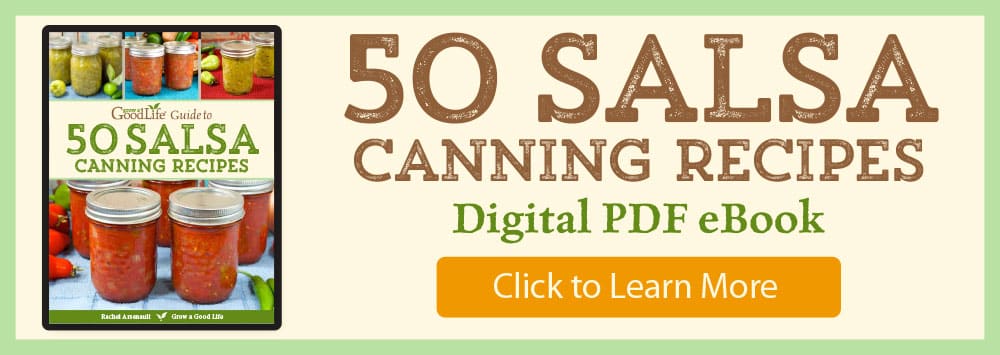
Thanks for sharing this great recipe. I followed the recipe exactly and wound up with 6 pint jars AND almost another whole pint (about 1 and 2/3 cup extra). I’m a bit worried though…. it’s quite sweet, almost as if I added sugar to it. I didn’t, of course, but some of the tomatillos I used were pretty ripe. So I wondering whether the use of ripe tomatillos is a problem for the recipe (i.e., will have affected the level of acidity). I did use a whole cup of fresh squeezed lime juice. It’s delicious…. just a bit sweet!
Keep up the great work… Love your recipes, they inspire me to grow new things!
Angela, Fully ripe tomatillos do taste sweeter. Once they turn yellow, they loose much of the tangy flavor. Roasting the tomatillos sweetens the flavor as well. As long as you followed the recipe, your jars are canned safely. If you don’t like the sweet flavor, you can add a bit of vinegar at serving time to balance the sweetness.
Hello! Wonderful recipe and instructions. I was wondering if I could add Serrano peppers as well? Thank you!
Jocelyn, Yes, you can replace the jalapeño peppers with Serrano peppers. Keep the amount of peppers the same.
So yummy! I have made it twice: once this past summer and once today (I cleaned out my extra freezer which had 5 lbs of tomatillos from my garden last summer).
The recipe is easy to follow and turned out great. The first batch I removed all the jalapeno seeds, and it is really good. The second batch I left in half and …its hot!! Both are perfect!
Now that I am getting better at growing my own veggies and canning, I think I am going to be gifting the recipe jars next Christmas (new batches of course) with some other goodies.
Thanks for taking the time to share it with us!!!
Kerrie, Thank you for letting me know. I am so glad you enjoyed the tomatillo salsa.
This recipe is a nice recipe but my family really preferred the old recipe. I had made hundreds of jars so is it possible to get a email copy of old recipe please.
Sheri, I am sorry to change the recipe on you. I have emailed you the previous version of the recipe. It can also be found on the NCHFP website if you would like to bookmark it.
Can the tomatillo’s be planted in containers? I live in the city, Massachusetts This year 1st time I grew tomatoes, cherry tomatoes, kale, cukes, cucumbers & herbs, lots of flowers right out on Main St. People were surprised & loved seeing my little City Farm! It was beautiful, therapeutic & I’m thinking towards next year. My family all loves Mexican & Spanish food this would be a great idea! Love the recipe I’m going to buy some tomatillo’s & make it. Thanks
Tina, I love that you grew a garden in the middle of a city! Yes, you can plant tomatillos in containers just like tomatoes. They do grow tall and branch out, so give them plenty of room. The branches are not as heavy as tomato plants, but a large container and a pole or tomato cage will help support the plant especially if it gets windy. Just keep in mind that you need at least two plants for cross-pollination.
OMG this tomatillo salsa verde was so delish!! I roasted my tomatillos, onions, garlic a d peppers outside on charcoal grill with hickory wood chips. Thia was the best salsa verde I’ve ever had. I followed the recipe exactly and I ended up with 6 pint jars and 1 half pint jar. This recipe is a keeper!🙂
Can I use dried cilantro in the recipe I can’t find fresh in the store? This is my first time growing tomitillos some of the husks are turning tan in color but the fruit doesn’t fill it do you know if they still be used? Thanks
Megan, Yes, you can substitute dried cilantro in place of fresh. Dried herbs have a more intense flavor. I would use about 2 tablespoons of dried cilantro or less. You can use the smaller tomatillos with the browning husks for this recipe. Drought or cool temperatures often stop the growing process, but the smaller tomatillos are still safe for canning.
I made mine with poblano peppers. All the flavor without the heat.
Does this recipe require it to be refrigerated once it is canned? How long will it last for unopened?
Amy, No refrigeration needed if the jars are canned properly. Store your jars in a cool, dark place and use within 12 months. Once the jar is open, refrigerate and use up within a week.
Can I can just the tomatillo by themselves without making salsa ? I have a abundant amount this year and have other recipes that dont require green salsa but just green sauce,,thanks
Udeylee, Yes, you can can tomatillos whole. Follow this recipe from the National Center for Home Canning: Preserving Tomatillos
This was my first year growing tomatillos as well. It seems like the Bush just kept putting on blossoms but I didn’t get many ripen. Finally when it was going to freeze we picked all the ones that seemed big enough. I’m wondering if I should prune back new growth next year, so the plant can focus on the fruit already set. So you know if that is a good idea?
I did have enough to make one batch with this recipe and it turned out pretty tasty I thought. This is the one I send to friends of they ask what recipe they should use. It did taste a little lemony before canning but my experience has been that the taste mellows out with the canning process. And like you said, it needs the acidity to be safe, so I say it’s worth it.
Megan, I think your plants just need an earlier start.
I sowed tomatillo seeds early under lights, about 6-8 weeks before our last frost. Then transplanted to the garden after all danger of frost is over. That is the only way the plants have time to mature before they are killed by frost. I am in Maine, zone 5.
I did have a few volunteers pop up in the garden this year. Like yours, the plants were covered with blossoms and small tomatillo husks, but the fruit didn’t have enough time to get very large or mature.